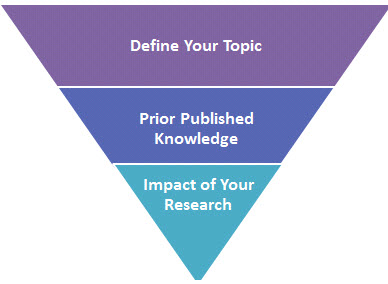 Boxer Library
Boxer Library

Your introduction is the chance to prepare your reader for the content of your paper. The purpose of the introduction is to provide the reader with the needed background knowledge, examples of that background knowledge in the form of research, and then how your study hopes to add to that body of knowledge. When putting together an introduction, think of it like an upside down triangle with the beginning being the broad description of your topic, followed by your literature review or the prior research conducted in your smaller research topic, and finish with the potential impact of your particular paper or study.
Strategies for Developing an Introduction
Tip: Write your introduction last, to ensure that all of essential information your reader needs is included.
Students new to writing research papers often confuse the abstract and introduction portions of their paper. Think of a paper like a movie with the abstract being the trailer, while the introduction is the first 20 minutes. The abstract gives you a summary of the whole paper, while the introduction gives you background information needed to understand the arguments in the paper.
|
Abstract |
|
|
Introduction |
|
Yes, in the introduction. Acronyms may seem universally understood especially if you are writing for a particular field, but it is still a good idea to write out the full phrase in the introduction, followed by the acronym.
You only have to do this once per acronym, because the reader will be able to refer back to the introduction if confused. The reason it is important to define it in this section is that certain acronyms can have multiple meanings.
Example:
ADA